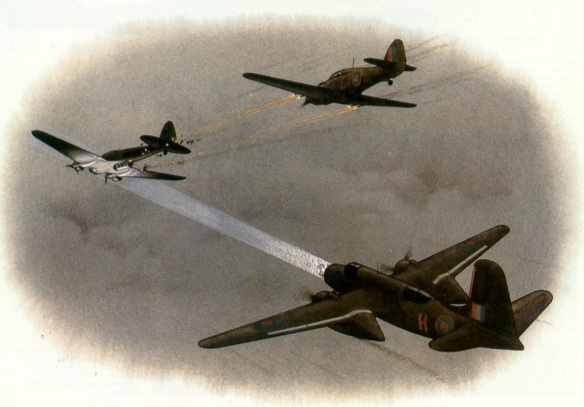A Royal Air Force Hawker Hurricane Mark IIC (s/n BE500, ‘LK-A’, “United Provinces Cawnpore”) being flown by Squadron Leader Dennis Smallwood, the Commanding Officer of No. 87 Squadron RAF based at RAF Charmy Down, Somerset (UK). No. 87 Squadron was one of the first RAF night fighter squadrons. Sqn Ldr Smallwood led the squadron in 1941-42, when most intercepts were made entirely without on-board radar. The aircraft is painted in an overall black scheme known in the RAF as “Special Night”.
BE500 subsequently served with No. 533 Squadron RAF and finally in the Far East.
From its earliest service days the Hawker Hurricane single-seater proved a pleasant aeroplane to fly at night (unlike the Supermarine Spitfire), and as early as the Battle of Britain Hurricanes were regularly flying night patrols to complement those of the night-fighter Bristol Blenheims. For example No. 92 (Fighter) Squadron operated a detached flight at Bibury in Gloucestershire for this work, As the daylight battle petered out in October the Hurricane was increasingly flown at night and with the introduction of the more powerful Hurricane Mk II with progressively heavier armament (eight machine-guns in the Hurricane Mk IIA, 12 machine-guns in the Hurricane Mk IIB and four 20-mm cannon in the Hurricane Mk IIC), the aircraft not only performed night defensive patrols but also became increasingly used as an intruder over German bomber bases in northern France and the Low Countries. Among the best known night fighter/intruder squadrons to fly Hurricane Mk IIs in 1941-2 were Nos 1, 3, 46, 79 and 87; to them was ascribed the destruction of 52 enemy aircraft, 16 coastal vessels, 105 road vehicles and 17 locomotives during the last six months of 1941. Without question the most successful pilot of this mid-war period was Flight Lieutenant Karel Kuttelwascher (a Czech veteran of the Battle of Britain) of No, 1 (Fighter) Squadron, who scored his first ‘intruder’ victory, a Junkers Ju 88, on 1 April 1942 and went on to shoot down 14 more enemy aircraft (seven Dormer Do 217s, five Heinkel He Ills, a Dornier Do 17 and another Ju 88) in the next eight weeks, for which he was awarded two DFCs: among his victories were three He 11 Is shot down over St André in the space of four minutes at midnight on 4/5 May, no mean feat for a single-seater without the benefit of radar.
The specialist night intruder Hurricane differed from its day fighter counterpart only in being painted matt black overall and having small antiglare panels between the engine exhaust stubs and the pilot’s windscreen. Hurricane Mk Us provided the first night-fighter equipment in the Middle East with the arrival of No. 213 Squadron in the Canal Zone in May 1941, and in May 1943 Hurricane Mk IICs with pilot-AI radar served with No. 176 Squadron in the Calcutta area.
Finally, mention should be made of the Turbinlite squadrons which, using searchlight- and AI-equipped Douglas Havocs and Douglas Bostons to locate enemy raiders, also flew Hurricane Mk IIBs and Mk IICs during 1942; an almost total absence of success, together with rapid development of AI radar, caused this wasteful and fruitless experiment to be abandoned in January 1943.
Specification
Hurricane Mk IIC Type: single-seat night-fighter/ intruder
Powerplant: one 1,280-hp(954-kW) Rolls-Royce Merlin XX V-12 liquid-cooled piston engine
Performance: maximum speed 546 km/h (339 mph) at 6705 m (22,000 ft); climb to 6095 m (20,000 ft) in 9 minutes 6 seconds; service ceiling 10850 m (35,600 ft); normal nightfighting range 740-km (460 miles)
Weights: empty 2631 kg (5,800 lb.); maximum take-off 3583 kg (7,800 lb.) Dimensions: span 12.19 m (40 ft 0 in); length 9.75 m (32 ft 0in); height 4.00 m (13 ft 1 1/2in); wing area 23.92 m2 (257.5 sq ft)
Armament: four wing-mounted 20-mm Hispano cannon, plus (intruder version) two 227-kg (500-lb) bombs
